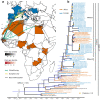Spatial and temporal dynamics of West Nile virus between Africa and Europe
- PMID: 37833275
- PMCID: PMC10575862
- DOI: 10.1038/s41467-023-42185-7
Spatial and temporal dynamics of West Nile virus between Africa and Europe
Abstract
It is unclear whether West Nile virus (WNV) circulates between Africa and Europe, despite numerous studies supporting an African origin and high transmission in Europe. We integrated genomic data with geographic observations and phylogenetic and phylogeographic inferences to uncover the spatial and temporal viral dynamics of WNV between these two continents. We focused our analysis towards WNV lineages 1 (L1) and 2 (L2), the most spatially widespread and pathogenic WNV lineages. Our study shows a Northern-Western African origin of L1, with back-and-forth exchanges between West Africa and Southern-Western Europe; and a Southern African origin of L2, with one main introduction from South Africa to Europe, and no back introductions observed. We also noticed a potential overlap between L1 and L2 Eastern and Western phylogeography and two Afro-Palearctic bird migratory flyways. Future studies linking avian and mosquito species susceptibility, migratory connectivity patterns, and phylogeographic inference are suggested to elucidate the dynamics of emerging viruses.
© 2023. Springer Nature Limited.
Conflict of interest statement
The authors declare no competing interests.
Figures


References
-
- Georgopoulou I, Tsiouris V. The potential role of migratory birds in the transmission of zoonoses. Vet. Ital. 2008;44:671–677. - PubMed
Publication types
MeSH terms
LinkOut - more resources
Full Text Sources
Medical

